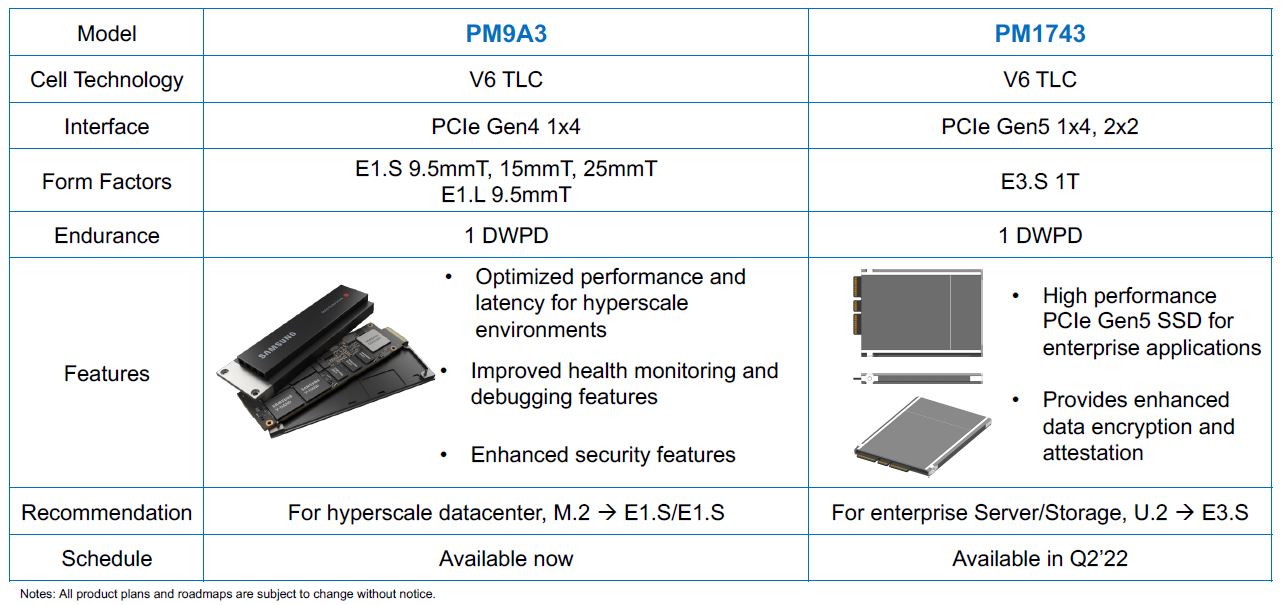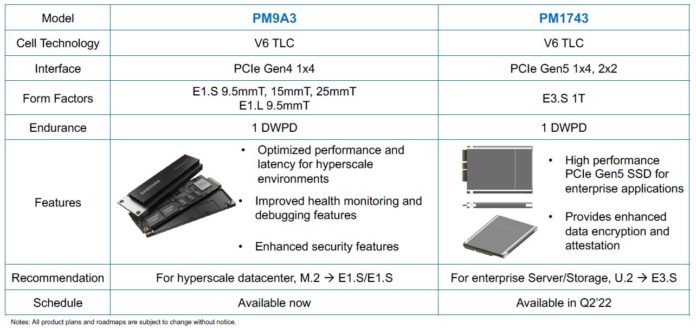Samsung put out a few details on an upcoming product for Q2 2022 when we expect the next-generation server systems to start shipping in higher volumes. Specifically, the Samsung PM1743 is a new SSD designed for the EDSFF era and higher speeds and densities in servers.
Samsung PM1743 PCIe Gen5 E3.S 1T EDSFF SSD Teased
Previously, we saw that Samsung announced another drive. The Samsung PM9A3 PCIe Gen4 NVMe Data Center SSDs was released for PCIe Gen4 systems. What is interesting is the specs that Samsung shared about its next-gen drive.

Samsung says the PM1743 is a V6 TLC-based drive with 1 DWPD of write endurance. It is also a 1T form factor drive which means it is the single-width form factor. E3.S 1T drives are designed for up to 20-25W of power. The 2T drives are designed for up to 35-40W and the E3.L 1T drives are also designed for up to 40W. As a result, and given the pictures this is likely going to be a 20-25W drive.
Samsung says it is a PCIe Gen5 1×4 (single port) or 2×2 (dual port) drive and seems to be showing a high-level mechanical drawing of the next-generation SSD.
Final Words
Overall, we know many EDSFF drives are coming. By 2025 most of the large vendors expect that in terms of capacity, EDSFF will capture around 50% of the total SSD market. Specifically though the transition is expected to mostly be a migration from 2.5″ to E1.S rather than 2.5″ to E3. That makes the Samsung PM1743 more of a niche drive than some of the E1.S offerings that we have been seeing.
If you want to learn more about the next-gen EDSFF form factors, you can check out our video here:
In that piece we go into some of the details and show off E1.S and E3.S drives. We use a Kioxia XD6 labeled E3.S drive in that video but it appears to be the same form factor as the PM1743.





the page refreshed while I was distracted and lost my comment, so I’ll try and summarise most concisely :
PCIE5? WHERE’S SAS4 / 24G? Does anyone know?
Silence from the industry. Microsemi announced customer testing in 2018. Nothing since.
Storage Spaces Direct from Microsoft is a very popular subsystem we originally deployed as a band aid to sites needing to understand their requirements. However Storage Spaces Direct has a served admirably and we’d like to extend the performance runway with SAS 24G. This software needs to be given a SAS subsystem.
I’ve a theory that management pre-emptive push back against the embrace of faster client network speeds is keeping legacy gigabit copper everywhere. Any manager who made that argument must have felt vindicated with WFH. But client area pools of fast storage PCIE4 giving even modest clients enough bandwidth, centrally managed and replicated / snapshot / using client bulk HDD capacity for DR / backup plan is something I think will become a important trend.
Microsoft bundling NVEOF drivers and a software controller, would kick-start this market overnight in enterprise client architecture development termd. Because I the way forward after WFH is workgroup locality. Home Town scale office facilities for mixing with main office and home days. Main Street needs this. I see federal tax breaks to encourage rollout.
Reason why gigabit clients still universal : fear of bandwidth bloat.
PCIE4 on the desktop? – workgroup SANs.
trigger? – Microsoft Storage Spaces Direct NVEoF / HDD DR / SD-WAN / SPR + HBM + Optane dwduplocation acceleration /
……
ScaleMP website “under construction” suddenly – this software cluster HAL needs to be given the job of joining up workgroups for resources composition and combined with a storage layer suite and must do something clever with the new top of the line AMD Instinct AIC besides acceleration for the storage. I’d like Azure Cognitive Services acceleration, and information protection classification and indexing.